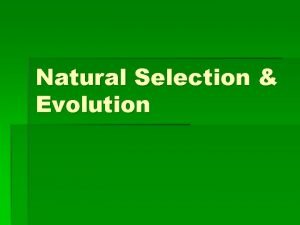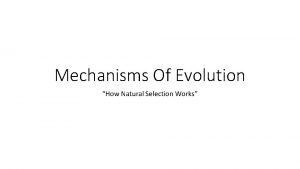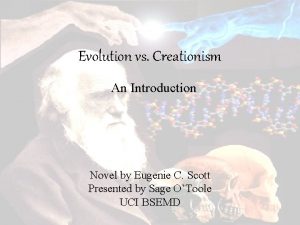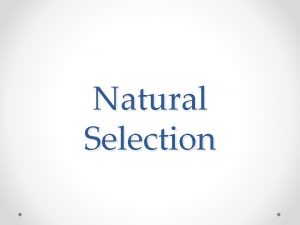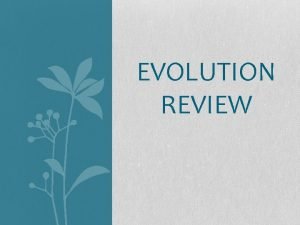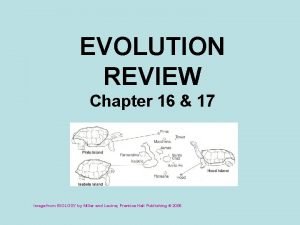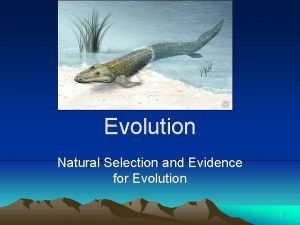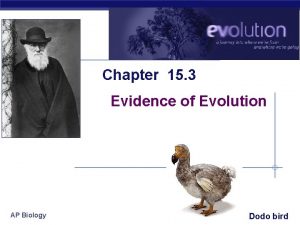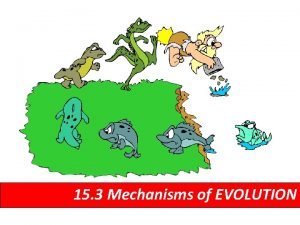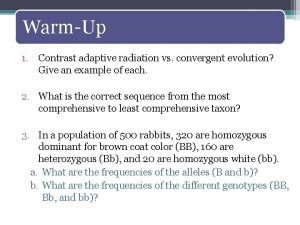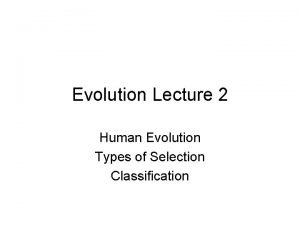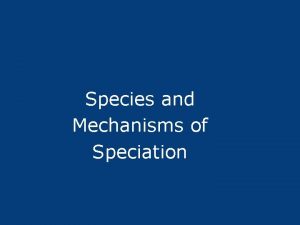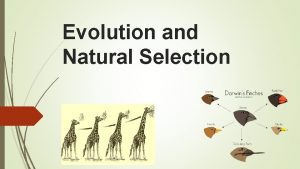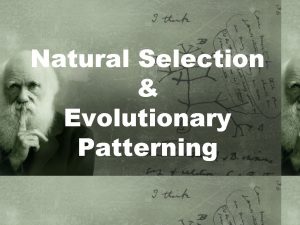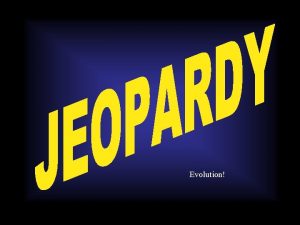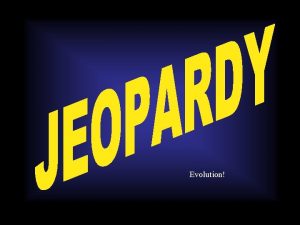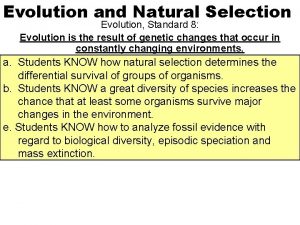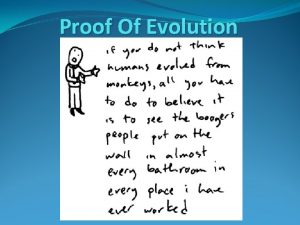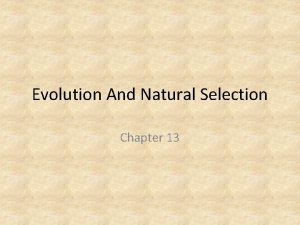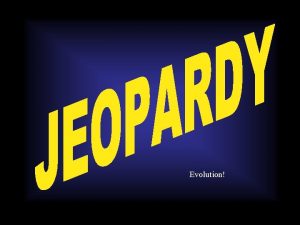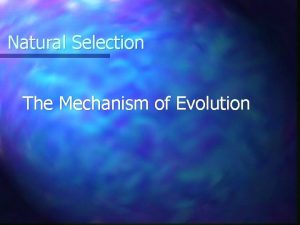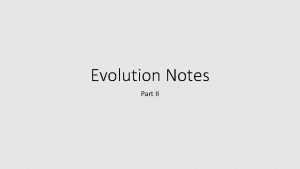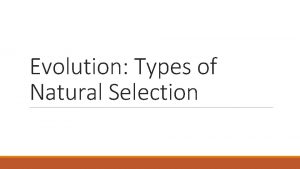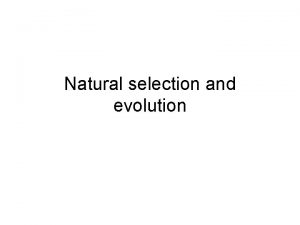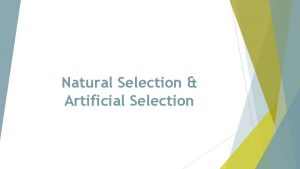Natural Selection 2 Adaptive Evolution Natural Selection Leading























- Slides: 23

Natural Selection 2 Adaptive Evolution

Natural Selection Leading to Adaptive Radiation • Life descends from shared ancestors • Changes over time via sexual reproduction, mutation etc • Favorable traits are selected for and therefore become more common in future generation - this is Natural Selection

Principles of Natural Selection • Individuals in the population are different • Variations are inheritable and can be subject to mutation • More offspring survive to sexual maturity and reproduce (causes competition) • Some individuals have traits that are better suited to their environment – they have desirable genetic information. More likely to be passed on to future offspring


Fitness • Natural selection produces changes over time within a population • Natural selection acts on the phenotypes of individuals, so some will survive and reproduce, while others will not – this is genetic fitness • Adaptive radiation comes from natural selection – mechanism which leads to new populations that are better suited to the environment

Artificial Selection • Requires human intervention • Only organisms with what we believe to be desirable traits are allowed to breed • Leads to establishment of new populations via artificial selection

Selection Pressures • Factors that influence the survival of an individual, a population or a species. • Competition – Food, shelter, territories – Within a species – With different species for same/similar resources • Predator-prey relationships • Sexual selection – Selection of traits that will attract mates

Sexual Selection

Sexual Selection • Linked to mating behaviour in animals • Form of selection where some inherited characteristics are considered more desirable • Those possessing these characteristics are more successful at finding mates

Sexual Selection • Special characteristics can sometimes be a hindrance to animals as energy has to go into making otherwise useless appendages e. g. antlers • Aside from energy cost, mating displays might attract predators • Still holds evolutionary advantage as traits correlate strongly to genetic fitness He’s the man

Sexual Dimorphism • Males and females of the same species have different appearances or size

Directional Selection • When individuals at one end of the curve have higher fitness than individuals in the middle or at the other end


Stabilizing Selection • When individuals near the center of the curve have higher fitness than individuals at either end of the curve


Disruptive Selection • When individuals at the upper and lower ends of the curve have higher fitness than individuals near the middle • Can create 2 distinct phenotypes


Microevolution • Small scale changes in gene frequency • Occurs in a few generations • Within a species/population • Small evolutionary changes • Observable changes • E. g bacterial resistance to antibiotics

Macroevolution • Large scale changes to gene frequencies • Occurs over a long period of time • At or above the level of species • Extended microevolution • Not directly observed • Fossil evidence • E. g. reptiles -> birds

Macroevolution – formation of new species that occupy different niches Microevolution – formation of subtle differences within the same speices


Are humans still evolving? • Yes – increased gene flow leads to greater heterozygosity in a population which can lead to health and survival • Recent gene changes – Skin pigmentation – Lactose tolerance – Breaking down alcohol – Early reproductive age in some comminities

Questions 1. Define microevolution 2. Define macroevolution 3. Describe one piece of evidence that supports the idea that humans are still evolving 4. In what way is the modern synthesis of theory of evolution different to that proposed by Darwin and Wallace? 5. Summarise the different processes that can lead to microevolution
 Bobbin leading principle
Bobbin leading principle Types of natural selection in evolution
Types of natural selection in evolution Mechanisms of evolution
Mechanisms of evolution Natural selection vs evolution
Natural selection vs evolution The slow gradual change in a species is called
The slow gradual change in a species is called Is adaptive radiation divergent evolution
Is adaptive radiation divergent evolution Divergent evolution vs adaptive radiation
Divergent evolution vs adaptive radiation 3 types of natural selection
3 types of natural selection Is adaptive radiation divergent evolution
Is adaptive radiation divergent evolution Anthoxanthum odoratum parapatric speciation
Anthoxanthum odoratum parapatric speciation Adaptive radiation vs convergent evolution
Adaptive radiation vs convergent evolution Similarities
Similarities Natural selection vs artificial selection
Natural selection vs artificial selection Artificial selection vs natural selection
Artificial selection vs natural selection Disruptive selection.
Disruptive selection. Natural selection vs artificial selection
Natural selection vs artificial selection Types of evolution
Types of evolution Sympatric vs allopatric
Sympatric vs allopatric Balancing selection vs stabilizing selection
Balancing selection vs stabilizing selection K selected
K selected Logistic model of population growth
Logistic model of population growth Two way selection and multiway selection in c
Two way selection and multiway selection in c Multiway selection
Multiway selection Mass selection and pure line selection
Mass selection and pure line selection

